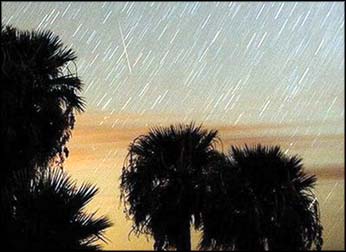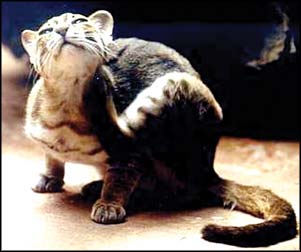|
-new-navin-2.jpg)
Diamond dust shows comets hit 12,900 years ago: study
Soil rich in diamond dust discovered across North America reinforces
(supports) a theory that falling meteors caused the extinction of
mammoths and other animals, said a study in the journal Science.
 |
| Perseid meteors streak
across the sky near Rogers Spring in the Lake Mead National
Recreation Area, Nevada. |
"These discoveries provide strong evidence for a cosmic impact event
approximately 12,900 years ago that would have had enormous
environmental consequences for plants, animals and humans across North
America," said Douglas Kennett of the University of Oregon, who led the
research.
The findings appear to bolster (boost) the theory set out in 2007
that several comets hitting the Earth triggered a 1,300-year-long ice
age, causing the extinction of several species of animals and fragmented
the prehistoric human Clovis culture.
The Clovis people lived off hunting and gathering in an area across
what is now the United States, Mexico and Central America.
The peak of the Clovis era was from 13,200 to 12,900 years ago and
scientists say the Clovis may have entered North America across a land
bridge from Siberia.
One of the diamond-rich sediment layers found by the researchers is
located directly above Clovis materials at a site in Murray Springs,
Arizona, the researchers said.
The nanometre-sized diamonds are produced under high temperatures and
high pressure from cosmic impacts that have been found in meteorites.
The sediments full of diamond dust were also found at digs at five
other sites, in Bull Creek, Oklahoma; Gainey, Michigan; and Topper,
South Carolina in the United States and Lake Hind, Manitoba; and Chobot,
Alberta in Canada.
Nanodiamonds can be produced on Earth, but only as a result of
high-explosive detonations (explosions) or chemical vapourisation.
The study appears in the January 2 edition of the journal Science.
-AFP
 Project
to develop Nawagamuwa Project
to develop Nawagamuwa
The Nawagamuwa temple and devala are places of worship which are
visited by most Buddhists and Hindus living in and around Colombo. A
project was inaugurated recently by the Government to develop this
sacred city.
The project is estimated to cost 75 million rupees. The construction
of trade stalls is being considered as the first step of the project,
while subways, restrooms, health facilities and a drainage system are
also earmarked to be built at a later stage.
The foundation stone for the trade stalls was laid recently. It is
estimated that the first stage of the project would cost three million
rupees.
Extending school bus service
 Some
of you may be daily users of Sisu Seriya, the school bus service jointly
introduced and operated by the Transport Ministry and the National
Transport Commission. If you are, you would be glad to know that this
service has increased its fleet to over 500. Some
of you may be daily users of Sisu Seriya, the school bus service jointly
introduced and operated by the Transport Ministry and the National
Transport Commission. If you are, you would be glad to know that this
service has increased its fleet to over 500.
Funds close to Rs. 200 million had been allocated by the Budget
towards Sisu Seriya with the objective of providing a better and
improved school bus service to Sri Lanka's students.
There are also plans to add 500 more buses to the fleet during the
course of this year.
The half-rate concessionary service which is currently in existence
would continue as another measure to ease the transport problems faced
by schoolchildren.
Mummy thought to be Queen Seshestet found in Egypt
Egyptian archaeologists have found the remains of a mummy thought to
be that of Queen Seshestet, the mother of a pharaoh who ruled Egypt in
the 24th century BC, the Egyptian government said.
After five hours spent lifting the lid of a sarcophagus in a pyramid
discovered south of Cairo last year, they found a skull, legs, pelvis,
other body parts wrapped in linen, and ancient pottery, the government's
antiquities department said.
They also found gold wrappings which would have been put on the
fingers of the mummified person. Grave robbers ransacked the burial
chamber in ancient times and stole the other objects.
- Reuters
World's smallest cat spotted
 While
there is very often gloomy news of wild animals being poached and their
pristine (pure) land being encroached, there are rare sightings of some
of the most fantastic creatures as well. A team of wildlife enthusiasts
spotted a rusty-spotted cat, one of the most endangered species and the
world's smallest cat, at Devrayanadurga reserved forests in Tumkur
district, India recently. While
there is very often gloomy news of wild animals being poached and their
pristine (pure) land being encroached, there are rare sightings of some
of the most fantastic creatures as well. A team of wildlife enthusiasts
spotted a rusty-spotted cat, one of the most endangered species and the
world's smallest cat, at Devrayanadurga reserved forests in Tumkur
district, India recently.
The rusty-spotted cat is found only in India and Sri Lanka and
measures only 14-17 inches in length. It weighs less than 1.5 kg
(females weigh less than 1 kg). Rusty-spotted cats are mostly found in
dry deciduous (shedding leaves in autumn) forests as well as scrub, and
are arboreal (living on trees). This wild cat mainly hunts small
rodents, birds and lizards.
"This cat is faced with the threat of extinction due to habitat loss
and the spread of cultivation. There have been occasional reports of
rusty-spotted cat skins in trade, or of them being killed for food or as
livestock pests.
This animal is protected under Schedule I of Wildlife Protection Act,
1972, and is classified under Appendix I of the Convention on
International Trade in Endangered Species of Wild Flora and Fauna
(CITES), banning trade of this animal to protect it from extinction,"
said Sanjay Gubbi, assistant director, Wildlife Conservation Society,
India Programme. Gubbi was part of the team in Devarayanadurga. He added
that the sighting of this rare cat is another reason to protect the 42
sq km reserved forests of Devarayanadurga which is host to other wild
animals.
Birth and death anniversaries from January 18-24
January 21
George Orwell, English author died in 1950.
January 22
Sir Francis Bacon, British statesman and philosopher was born in 1561.
Shah Jehan, Moghul Emperor of India died in 1666.
Queen Victoria of England died in 1901.
January 23
Anna Pavlova, Russian ballerina, died in 1931.
January 24
Sir Winston Churchill, British Prime Minister, died in 1965.
Special events which took place in history, from January 18-24
January 18
Hawaii was discovered by Captain Cook in 1778.
St. Peter's College, Wellawatte was established in 1922.
The distribution of free school books was inaugurated in 1980.
January 19
Captain Wilkes discovered the Antarctic coast in 1840.
Indira Gandhi became Prime Minister of India in 1966.
January 20
John F. Kennedy became President of the USA in 1964.
January 21
University College, Colombo was established in 1921.
The first Sinhala feature film Kadavunu Poronduwa was screened for the
first time
in 1947.
Nautilus, the first nuclear submarine was launched in 1954.
January 22
Zahira College, Colombo was founded in 1892.
January 23
The National Youth Services Council was established in 1969.
January 24
Sri Wickrama Rajasinghe, the last King of Kandy, and his family were
deported to
Vellore, India in 1816.
Gold was first discovered in California in 1848.
The first Boy Scouts troops were formed in England in 1908.
Compiled by Asha Senevirathne
|

